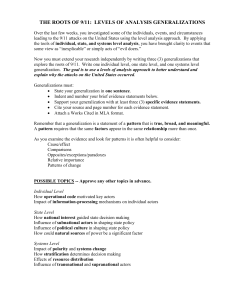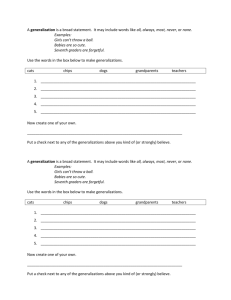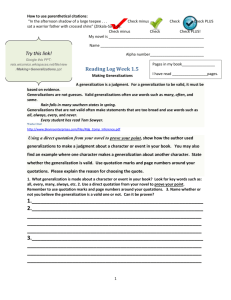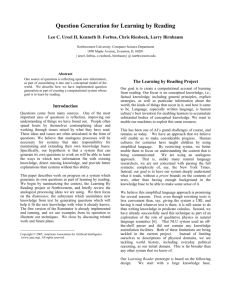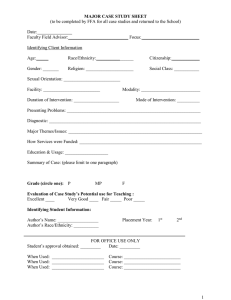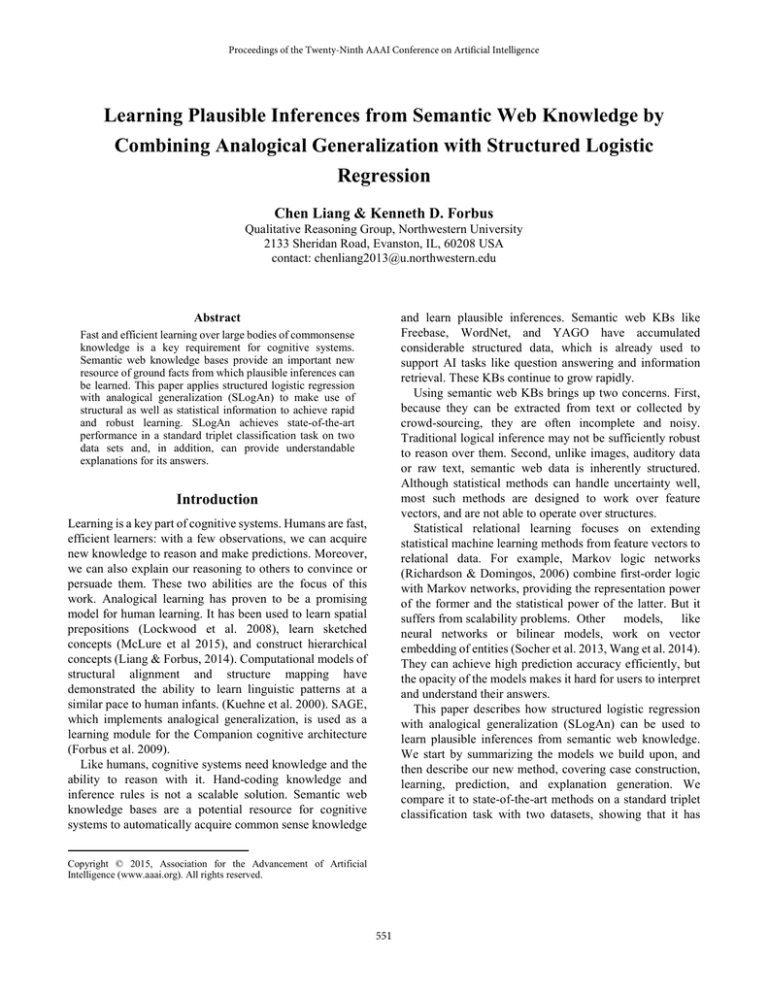
Proceedings of the Twenty-Ninth AAAI Conference on Artificial Intelligence
Learning Plausible Inferences from Semantic Web Knowledge by
Combining Analogical Generalization with Structured Logistic
Regression
Chen Liang & Kenneth D. Forbus
Qualitative Reasoning Group, Northwestern University
2133 Sheridan Road, Evanston, IL, 60208 USA
contact: chenliang2013@u.northwestern.edu
and learn plausible inferences. Semantic web KBs like
Freebase, WordNet, and YAGO have accumulated
considerable structured data, which is already used to
support AI tasks like question answering and information
retrieval. These KBs continue to grow rapidly.
Using semantic web KBs brings up two concerns. First,
because they can be extracted from text or collected by
crowd-sourcing, they are often incomplete and noisy.
Traditional logical inference may not be sufficiently robust
to reason over them. Second, unlike images, auditory data
or raw text, semantic web data is inherently structured.
Although statistical methods can handle uncertainty well,
most such methods are designed to work over feature
vectors, and are not able to operate over structures.
Statistical relational learning focuses on extending
statistical machine learning methods from feature vectors to
relational data. For example, Markov logic networks
(Richardson & Domingos, 2006) combine first-order logic
with Markov networks, providing the representation power
of the former and the statistical power of the latter. But it
suffers from scalability problems. Other models, like
neural networks or bilinear models, work on vector
embedding of entities (Socher et al. 2013, Wang et al. 2014).
They can achieve high prediction accuracy efficiently, but
the opacity of the models makes it hard for users to interpret
and understand their answers.
This paper describes how structured logistic regression
with analogical generalization (SLogAn) can be used to
learn plausible inferences from semantic web knowledge.
We start by summarizing the models we build upon, and
then describe our new method, covering case construction,
learning, prediction, and explanation generation. We
compare it to state-of-the-art methods on a standard triplet
classification task with two datasets, showing that it has
Abstract
Fast and efficient learning over large bodies of commonsense
knowledge is a key requirement for cognitive systems.
Semantic web knowledge bases provide an important new
resource of ground facts from which plausible inferences can
be learned. This paper applies structured logistic regression
with analogical generalization (SLogAn) to make use of
structural as well as statistical information to achieve rapid
and robust learning. SLogAn achieves state-of-the-art
performance in a standard triplet classification task on two
data sets and, in addition, can provide understandable
explanations for its answers.
Introduction
Learning is a key part of cognitive systems. Humans are fast,
efficient learners: with a few observations, we can acquire
new knowledge to reason and make predictions. Moreover,
we can also explain our reasoning to others to convince or
persuade them. These two abilities are the focus of this
work. Analogical learning has proven to be a promising
model for human learning. It has been used to learn spatial
prepositions (Lockwood et al. 2008), learn sketched
concepts (McLure et al 2015), and construct hierarchical
concepts (Liang & Forbus, 2014). Computational models of
structural alignment and structure mapping have
demonstrated the ability to learn linguistic patterns at a
similar pace to human infants. (Kuehne et al. 2000). SAGE,
which implements analogical generalization, is used as a
learning module for the Companion cognitive architecture
(Forbus et al. 2009).
Like humans, cognitive systems need knowledge and the
ability to reason with it. Hand-coding knowledge and
inference rules is not a scalable solution. Semantic web
knowledge bases are a potential resource for cognitive
systems to automatically acquire common sense knowledge
Copyright © 2015, Association for the Advancement of Artificial
Intelligence (www.aaai.org). All rights reserved.
551
competitive performance, and, at the same time, can provide
understandable explanations for its answers.
returned item is less than an assimilation threshold, the new
example is stored as is. Otherwise, if the returned item is a
generalization, the new example is assimilated into it. If the
returned item is a previously unassimilated example, then
the two are combined into a new generalization.
The assimilation process increments frequency counts
associated with each statement, based on whether or not
something in the example aligned with it. For a new
generalization, such facts are always either 1.0 (in both) or
0.5. If, for example, one black cat and two grey cats had
been seen, then P[(primaryObjectColor <GenEnt> Black)]
= 1/3. Facts whose probabilities drop too low are pruned, for
efficiency. Importantly, these generalizations do not have
logical variables: When non-identical entities are aligned, as
in the cats example, a new arbitrary individual (called
<GenEnt> above) is constructed to stand for the aligned
individuals, with its characteristics being determined by the
set of statements in the generalization that constrain it.
In most semantic web KBs, knowledge is stored in the
triplet format: "entity relation entity". Since there are only
binary relations, it can be seen as a labeled, directed graph.
Each entity is a node, and each triplet between two entities
is an edge labeled with the relation. Semantic web KBs have
been used in a variety of tasks, including triplet
classification. Given triplets extracted from a KB, the
system should learn to distinguish correct triplets like
"Obama nationality USA" from incorrect ones like "Obama
nationality Kenya". Then, the learned model is tested on a
holdout test set, with performance measured by
classification accuracy.
Background
We assume Gentner’s (1983) structure-mapping theory. Our
model is built upon the Sequential Analogical
Generalization Engine (SAGE; McLure et al. 2010), which
in turn uses the Structure-Mapping Engine (Falkenhainer et
al. 1989) for analogical comparison and MAC/FAC (Forbus
et al. 1995) for analogical retrieval. We start with SME
since it is the most fundamental. SME takes as input two
structured representations, a base and target, and produces
one or more mappings. Each mapping provides a set of
correspondences (i.e. what goes with what), a structural
evaluation score which provides an overall estimate of
match quality, and candidate inferences. We refer to the
similarity score of a mapping as NSIM(base,target), which
is normalized to [0,1] by dividing the raw score by the mean
of the self-scores of the base and target1. Forward candidate
inferences go from base to target, reverse candidate
inferences go from target to base. MAC/FAC takes as input
a case library, which is a set of structured descriptions, and
a probe, which is a structured description. It returns one or
more approximations to the most similar case in the case
library, using a two-stage process that enables it to scale to
large case libraries. The first stage uses a flattened version
of the relational structure of cases, called content vectors,
whose dimensions are proportional to the weighted number
of occurrences of each predicate in a description. The dot
product of two content vectors is an estimate of SME’s
structural evaluation score for the structured representations,
making it a useful coarse filter. Both SME and MAC/FAC
have been used to model a variety of psychological
phenomena.
SAGE maintains, for each concept, a generalization
context. A generalization context has a trigger, which is
used to test whether or not an incoming example should be
added to it. (An incoming example might satisfy multiple
triggers, and hence be processed by several generalization
contexts.) Each generalization context maintains a set of
generalizations and a set of unassimilated examples. (Either
of these sets might be empty, and both are initially.)
Generalizations are also structured representations, but
associated with their statements are probabilities, based on
the number of times facts that align with them are found in
examples that are part of that generalization.
Every time a new example is added, SAGE uses
MAC/FAC to retrieve up to three examples or
generalizations, based on whatever is the most similar to the
new example. If nothing is retrieved, or the similarity to the
Method
We extend analogical generalization with structured logistic
regression to make use of the structural as well as the
statistical information in the semantic web KB. The goal is
to learn what kinds of inferences are plausible. For example,
when learning about relation “nationality”, we are not
learning what people from different countries look like.
Instead, we are learning about how to infer a person’s
nationality. One possible inference might be “this person
comes from Chicago, and I know several people from
Chicago. What are their nationalities?”
Case construction by path-finding
The first step is to prepare the input data. Analogical
comparison and generalization work on cases. For this task,
cases contain structured information about particular triplets.
The idea is to include enough information to enable the
1
The mapped representations are subsets of both base and target, so its score
is lower than either of their self-scores.
552
Figure 1: Intended workflow for SLogAn. The learning system gets input from semantic web knowledge base, does template learning
and weight adjustment with the data. Using the learned generalizations, it provides answers, with explanations, for the user’s
queries. Natural language generation (dashed lines) is not yet implemented.
system to distinguish correct from incorrect triplets, while
limiting the size of the cases for the sake of efficiency and
to reduce the number of irrelevant matches.
As discussed above, a semantic web KB can be viewed as
a graph. We use path-finding as a heuristic to pick relevant
facts for case construction. For example, when we want to
create a case for a triplet with A and B as head and tail
entities, we use depth-first-search to find paths between
them and put all the facts along the paths found into the case.
In a large scale and highly connected knowledge base, an
exhaustive search will be prohibitive, so we use limits on
branching factor and search depth to randomly select parts
of the search tree to explore.
These two thresholds control the tradeoff between
information and efficiency. The larger the branching factor,
the more information is in the case, and the larger the search
depth, the more distant are the relationships between the two
entities that can be found. The bound on branching factor is
applied to each type of relation separately. For example, if
we hit the entity "Chicago" in the search, and it has a
"location" relation with 100 people and a "place_of_birth"
relation with 10 people and the upper limit is 20, we
randomly select 20 of the 100 Chicagoans to explore, and
use all of the 10 people born in Chicago to explore, because
the number is less than 20.
The intuition is that the facts we use to infer a relation will
be represented by a small number of fixed paths between the
entities in the case. In other words, if some relation holds
between two entities, they are likely to be indirectly related
to each other in some other ways.
Since there are only positive examples in the original
dataset, we corrupt the correct triplets by changing their tail
entities to wrong ones to get negative examples, just like
Socher et al. (2013) did. We treat the training set as our
knowledge base, and create cases from it. With just a few
cases, SLogAn is able to learn plausible inferences. For the
triplet classification task, we used only 10 positive and 10
negative examples for each relation.
Analogical generalization: structural alignment for
template learning
The second step is to decide what to include in the inference,
i.e., learning a template for the inference. This is done by
SAGE. As outlined above, SAGE can create generalizations
by comparing examples and compressing them into one
prototype. A generalization works as a template for an
inference. It is trivial to compare feature vectors because
they all share the same dimensions, but it takes some effort
to find the best way to align structured representations of
examples and compress them into one structurally
consistent template that summarizes the facts. SME does
this job by finding the best structural alignment with
systematicity as main criterion and several constraints to
ensure structural consistency. We also require the head
entity and tail entity of one triplet to be respectively matched
to those of the other triplet in the mapping to make sure they
are the focus of the template. Note that, unlike the way
553
Explanation for (taufaahau_tupou_iv ethnicity tongans):
Evidence 1: (taufaahau_tupou_iv parents viliami_tungi_mailefihi) (viliami_tungi_mailefihi ethnicity tongans)
Evidence 2: (viliami_tungi_mailefihi children taufaahau_tupou_iv) (viliami_tungi_mailefihi ethnicity tongans)
Evidence 3: (taufaahau_tupou_iv nationality tonga) (george_tupou_i_of_tonga nationality tonga) (george_tupou_i_of_tonga ethnicity tongans)
comment: I believe Taufa'ahau Tupou IV's ethnicity is Tongan, because I know his parent's ethnicity is Tongan, and I remember a person from the
same country as him, whose ethnicity is also Tongan.
Explanation for (qusay_hussein parents saddam_hussein):
Evidence 1: (qusay_hussein parents sajida_talfah) (uday_hussein parents sajida_talfah) (uday_hussein parents saddam_hussein)
Evidence 2: (qusay_hussein parents sajida_talfah) (uday_hussein parents sajida_talfah) (saddam_hussein children uday_hussein)
Evidence 3: (qusay_hussein parents sajida_talfah) (saddam_hussein spouse sajida_talfah)
comment: I believe Saddam is Qusay’s parent, because I know Saddam is Qusay’s sibling Uday’s parent and Qusay’s parent Sajida’s spouse.
Explanation for (vuk_stefanovic_karadzic religion serbian_orthodox_church):
Evidence 1: (vuk_stefanovic_karadzic ethnicity serbs) (gavrilo_princip ethnicity serbs) (gavrilo_princip religion serbian_orthodox_church)
Evidence 2: (vuk_stefanovic_karadzic ethnicity serbs) (zoran_in_ic ethnicity serbs) (zoran_in_ic religion serbian_orthodox_church)
Evidence 3: (vuk_stefanovic_karadzic ethnicity serbs) (alexander_i_of_yugoslavia ethnicity serbs) (alexander_i_of_yugoslavia religion
serbian_orthodox_church)
comment: I believe Vuk Stefanovic Karadzic's religion is the Serbian orthodox church, because I can recall several persons with the same ethnicity,
whose religion is the Serbian orthodox church.
Figure 2: Examples of explanations and comments: with only ground facts and no prior knowledge about the relations, the system
learns to make inference about them with high accuracy and provide the explanations for its answers. The comments are generated
manually.
in the template is associated with a weight measuring its
positive support. So if a fact contradicts the target relation,
it gets a negative score. We use the probability of each fact
as an initial value for its weight. To further adjust the
weights, we propose structured logistic regression, which is
an extension of logistic regression from feature vectors to
structured cases by combining it with structure mapping.
Structured logistic regression works as follows. Given an
example, we compare it to the generalization with SME.
With the resulting mapping, we compute the prediction
score of the example being a positive example with
SAGE is usually used, we first created generalizations with
positive examples only, and then add negative examples to
these generalizations so that they contain facts from positive
as well as negative examples. In this way, some facts could
contribute negatively to the target relation. For example, if I
know that B is A's parent, then A cannot be B's parent.
Although that fact never appears in a positive example, it is
still a critical fact to consider in the inference.
Using multiple generalizations together as one template
has strong expressive power. Learning plausible inferences
is similar to learning the concept of the target relation. A
concept can be represented by several generalizations in a
generalization context, which is analogous to a disjunctive
normal form. Each generalization can be seen as a
conjunction of facts inside it. Facts with negative weights
play the role of negations. Combining multiple
generalizations forms a disjunctive representation of the
concept. If we also combine the generalizations with
structured logistic regression, the model can be seen as a
structured 2-layer neural network. Each generalization plays
the role of a logistic unit, but the weight vector of the unit in
standard neural network is changed to a structured template
with associated weights to handle structured input instead of
feature vectors. Correspondingly, the dot-product operation
to activate a unit in standard neural network is replaced with
a structure mapping process. In this triplet classification task,
although multiple generalizations can help in accuracy, we
did not use them for the sake of efficiency.
=
1
1 + ݁ ି௦
where ݏis the similarity score computed by SME. Then, we
use cross entropy to define the prediction error and L1
regularization to promote sparsity in weights for better
explanation generation:
= ܬ−
[(1 − ݕ ) log(1 − ) + ݕ log( )] + ߙ
ୀ
ୀଵ
|ݓ |
݊ and ݉ are the number of examples and facts in the
generalizations respectively. ݕ and are the label (1 for
positive, 0 for negative) and prediction score of the ith
example. ߙ controls the strength of the regularization. Since
this error depends on similarity score and similarity score
depends on the weights, we can calculate the derivate of the
error with respect to the weights and do gradient descent on
them. The prediction error on the validation set is used to
decide when to stop the weight adjustment.
Structured logistic regression: structure mapping and
gradient descent for weight adjustment
The third step is to learn how much each fact in the template
supports or contradicts the target relation. Each expression
554
Other methods have been tested on exactly the same
datasets, making the results useful for comparison. Table 2
shows accuracy performances from Wang et al (2014).
SLogAn is 2nd on WN11 and FB13, and no method
consistently outperforms it on both datasets. Thus our
method performs at a level that is competitive with the stateof-the-art. Other approaches have not provided information
concerning statistical significance, so we will not be able to
compare that against them. The difference between SLogAn
and chance is statistically significant with < 0.001 .
Prediction accuracies of different relations are shown in
Table 3. SLogAn learns from the data collected by pathfinding during case construction, so its performance drops
on relations like “similar to” because it is hard to find a path
Prediction and explanation generation by finding
most weighted paths
After training, the model has learned to assign high scores
to the positive examples and low scores to the negative
examples. We use the validation set to decide the criterion ܿ.
When the score is larger than ܿ , the model predicts true,
otherwise it predicts false.
Explanations are representations of one’s own reasoning
which can be understood by others. Since SLogAn uses the
structured representation directly, it is more interpretable for
the user. By finding the highest weighted paths, we could
provide understandable explanations. The intuition here is
that each path between two entities represents one inference
chain. From the weights, we can know whether a given
inference chain supports or contradicts the target relation,
and how important it is. Given a path between the two
entities in the query triplet, we use the average weight of the
facts along this path as its weight. Then, we rank the paths
with the absolute value of their weights. Finally, we pick
several paths on the top as the explanation for the answer.
To make the explanation clearer to the user, we use L1
regularization to induce sparsity in the weight adjustment,
so that it prefers a few high weights rather than many low
weights, in other words, it provides a few strong pieces of
evidence rather than many weak pieces of evidence.
Model
38,696
112,581 2,609
10,544
FB13
13
75,043
316,232 5,908
23,733
53.0
75.2
Hadamard Model
Single Layer Model
70.0
69.9
63.7
85.3
Bilinear Model
Neural Tensor Network
73.8
70.4
84.3
87.1
TransH
SLogAn
78.8
75.3
83.3
85.3
WordNet11
#Validation #Test
11
Distance Model
in the KB between entities like “adamant_1” and
“physiologist_1”, although they are “similar to” each other.
The results provided by other methods are opaque to users.
Since they are based on vector embedding, they cannot
easily explain why they make certain predictions. In contrast,
we work on the structured data directly. From the
To test it, we compare SLogAn’s performance to state-ofthe-art performance on the triplet classification task. The
datasets were collected by Socher et al. (2013). One dataset
contains triplets from Freebase consisting of 13 relations
and 38,696 entities, the other dataset, from WordNet,
consisting of 11 relations and 75,043 entities. More
information about the number of triplets in training,
validation and test sets is shown in Table 1.
WN11
Freebase13
Table 2: Triplet classification accuracy (%) of different models
Experiment
Datasets #Relations #Entities #Train
WordNet11
Table 1: Statistics of WordNet and Freebase datasets
As for the hyperparameters, the limit on branching factor
is 20 and the search depth is 3 for FB13 and 5 for WN11,
which is chosen based on run time limit. (On average, one
entity in FB13 has 316232/75043 ≈ 4.2 outgoing triplets,
while the same number is 112581/38696 ≈ 2.9 in WN11, so
the search depth is lower on FB13.) For each relation, we
randomly select 10 triplets as positive examples, and create
their corresponding negative examples as training data. The
regularization parameter ߙ is set to 0.01, which is decided
by prediction error on validation set.
accuracy
Freebase13
accuracy
has instance
74.5
gender
85.9
type of
member meronym
76.9
75.8
nationality
profession
94.6
81.4
member holonym
part of
74.2
72.0
institution
cause of death
79.4
76.9
has part
subordinate instance of
73.5
81.7
religion
ethnicity
82.2
87.9
domain region
69.9
synset domain topic
similar to
76.0
50.0
domain topic
69.0
Table 3: Triplet classification accuracy (%) of different relations
explanation the model provides, the user is able to see how
its reasoning works. Examples of explanations are shown in
Figure 2. Note that unfamiliar examples are intentionally
chosen to show how explanations help with human
555
to construct plausible inference patterns, whereas SLogAn
is learning from purely ground facts. Integrating these
methods could prove valuable. Richards & Mooney (1992)
uses path-finding to find candidate clauses for learning firstorder rules, but it was computationally expensive. Lao et al.
(2011) used limited-length path-finding in NELL
knowledge base to create features and do logistic regression
with them. As is discussed above, SLogAn can use multiple
generalizations to handle disjunctive concepts, and thus has
more expressive power. Also note that SLogAn can
potentially work with other case construction methods as
long as they provide structured representations of relevant
information.
Structural logistic regression (Popescul & Ungar, 2003)
generates features by propositionalizing first-order rules
learned by inductive logic programming, and uses logistic
regression with these features for classification. Relational
logistic regression (Kazemi et al. 2014) uses logistic
regression to learn weights for first-order formulae in
defining the conditional probability of a new relation given
those formulae. Their ways of adding the counts of certain
facts as features are possible improvements for the current
model. Although the triplet classification task only deals
with binary relations, SLogAn has the ability to deal with
higher arity and high-order relations because it builds on
SME and SAGE, which can handle them. Halstead &
Forbus (2005) takes a similar approach to this work. They
used SAGE to generate probabilistic generalizations to turn
structured cases into features and built a Bayesian network
on top of them to make predictions.
Deductive systems like Cyc and SHAKEN (Clark et al.
2001) can also provide explanations, but those explanations
tend to be narrow and deeply nested, whereas the
explanations produced by our current system are broad and
shallow, more akin to explanations found in evidential
reasoning arenas (e.g. intelligence analysis). Extensions to
handle deeper nested inference by adding more levels to the
current system are interesting, and will be crucial for
learning more complex yet still interpretable models for
prediction.
validation of the results and increase trust in prediction: even
without explanations, familiar examples are easy for people
to validate. We used the top 3 most weighted paths as the
explanation for each example.
Discussion
SLogAn learned plausible inferences from semantic web
knowledge to achieve competitive performance to state-ofthe-art methods on the triplet classification task, and,
moreover, provides understandable explanations. These two
abilities would make a cognitive system more autonomous
and independent because it does not need to be told about
everything it will be asked for, and more trustworthy and
helpful because it can explain its answer to the user.
For example, when asked about “is Taufa'ahau Tupou
IV’s ethnicity Tongan?”, even though the system is not told
about this fact or how to infer one’s ethnicity, it can learn it
from several examples it knows of the relation “ethnicity”
and makes a prediction based on its knowledge of
Taufa'ahau Tupou IV and Tongan with reasonable accuracy.
If the users are only provided with the answer, they have to
decide whether to believe it or not based on their trust of the
system. However, if the system could say, “I believe
Taufa'ahau Tupou IV’s ethnicity is Tongan, because I know
his parent’s ethnicity is Tongan, and I remember a person
with the same nationality whose ethnicity is also Tongan”,
it is easier to convince the users when the system is correct,
and alert them when the system is wrong. It would make
cooperation more efficient and natural, by reducing the
labor of human validation.
Related work
Many vector embedding based methods have been tested on
the triplet classification tasks. Socher et al. (2013) and Wang
et al. (2014) are the most recent and have the best
performance. Their models are quite different from ours.
They learn vector representations for the entities and
parameterization (translation or tensor) for each relation that
implicitly encode the knowledge about them. During
training, they created negative examples for every triplet in
the training set and train on all of them. In contrast, SLogAn
only randomly selects a few triplets and creates cases and
corresponding negative examples for them. Instead of
implicit encoding of knowledge with vector embedding, we
use the structured knowledge directly and learn
generalizations that explicitly encode valid inferences. This
gives our model interpretability. Moreover, SLogAn can
learn each relation separately, while theirs have to learn all
the relations together.
Several previous efforts have used path-finding for
relational learning. Sharma & Forbus (2010) used higherorder knowledge about relations and reinforcement learning
Conclusion and future work
This work shows that analogical generalization and
structure mapping can be combined with statistical machine
learning methods to achieve state-of-the-art performance on
a standard task, while preserving interpretability. It enables
cognitive systems to learn from structured data, e.g.
semantic web resources, to do reasoning with what they
have learned, and to explain their reasoning to the user.
We plan to explore several future directions. First,
semantic web knowledge typically contains only binary
relations involving entities. However, SME and SAGE are
556
Kazemi, S. M., Buchman, D., Kersting, K., Natarajan, S., & Poole,
D. (2014). Relational logistic regression. Proc. 14th International
Conference on Principles of Knowledge Representation and
Reasoning (KR-2014).
Kuehne, S., Gentner, D. and Forbus, K. (2000). Modeling infant
learning via symbolic structural alignment. Proceedings of CogSci
2000, August.
Lao, N., Mitchell, T., & Cohen, W. W. (2011). Random walk
inference and learning in a large scale knowledge base.
Proceedings of the Conference on Empirical Methods in Natural
Language Processing, Edinburgh, United Kingdom.
Lee, H., Grosse, R., Ranganath, R., & Ng, A. Y. (2011).
Unsupervised learning of hierarchical representations with
convolutional deep belief networks. Communications of the ACM,
54(10), 95-103.
Liang, C. and Forbus, K. (2014). Constructing Hierarchical
Concepts via Analogical Generalization. Proceedings of the
Cognitive Science Society.
Lockwood, K., Lovett, A., & Forbus, K. (2008). Automatic
classification of containment and support spatial relations in
English and Dutch. In Spatial Cognition VI. Learning, Reasoning,
and Talking about Space (pp. 283-294). Springer Berlin
Heidelberg.
McLure, M., Friedman, S., & Forbus, K. (2015). Extending
Analogical Generalization with Near-Misses. Proceedings of
AAAI-2015.
McLure, M., Friedman, S., & Forbus, K. (2010). Learning concepts
from sketches via analogical generalization and near-misses.
Proceedings of the 32nd Annual Conference of the Cognitive
Science Society (CogSci), Portland, OR.
Popescul, A., & Ungar, L. H. (2003). Structural logistic regression
for link analysis. Departmental Papers (CIS), 133.
Richards, B. L., & Mooney, R. J. (1992). Learning relations by
pathfinding. Proceedings of the tenth national conference on
Artificial intelligence.
Richardson, M., & Domingos, P. (2006). Markov logic networks.
Machine learning, 62(1-2), 107-136.
Sharma, A. and Forbus, K.D. (2013). Graph Traversal Methods for
Reasoning in Large Knowledge-Based Systems. Proceedings of
the Twenty-Seventh AAAI Conference on Artificial Intelligence
(AAAI-13), Bellevue, Washington.
Socher, R., Chen, D., Manning, C. D., & Ng, A. (2013). Reasoning
With Neural Tensor Networks for Knowledge Base Completion.
Proceedings of Advances in neural information processing
systems.
Wang, Z., Zhang, J., Feng, J., & Chen, Z. (2014). Knowledge
Graph Embedding by Translating on Hyperplanes. Proceedings of
Twenty-Eighth AAAI Conference on Artificial Intelligence.
designed to work on cases that also include high-order
relations that express arguments and explanations. We plan
to test this method with representations produced via
learning by reading systems (Forbus et al. 2007) and sketch
understanding systems (Forbus et al. 2011). Second, we plan
to compare its performance to other SRL methods on other
tasks, such as link prediction. Third, unsupervised learning
of high-level representations to disentangle independent
factors and discover patterns has recently drawn a lot of
attention (Lee et al. 2011, Bengio, 2009). The learned
representations can be used to represent the input more
compactly and help supervised learning to achieve better
performance. Extending the current model to learn highlevel representations for structured examples that are
understandable, more compact and useful for supervised
learning is a promising direction. Fourth, we plan to
integrate it into our Companion cognitive architecture, to
provide a new learning capability and exploit Companion’s
interaction capabilities to implement the full workflow of
Figure 1.
Acknowledgements
This research was sponsored by the Socio-Cognitive
Architectures Program of the Office of Naval Research,
N00014-13-1-0470.
References
Bengio, Y. (2009). Learning Deep Architectures for AI. Found.
Trends Mach. Learn., 2(1), 1-127. doi: 10.1561/2200000006
Clark, P. et al. (2001). Knowledge entry as the graphical assembly
of components. Proceedings of the 1st international conference on
Knowledge capture (pp. 22-29). ACM.
Falkenhainer, B., Forbus, K. D., & Gentner, D. (1989). The
structure-mapping engine: Algorithm and examples. Artificial
intelligence, 41(1), 1-63.
Forbus, K., Riesbeck, C., Birnbaum, L., Livingston, K., Sharma,
A., & Ureel, L. (2007). Integrating Natural Language, Knowledge
Representation and Reasoning, and Analogical Processing to Learn
by Reading. Proceedings of AAAI-07.
Forbus, K., Usher, J., Lovett, A., Lockwood, K., & Wetzel, J.
(2011). CogSketch: Sketch Understanding for Cognitive Science
Research and for Education. Topics in Cognitive Science, 3(4),
648-666. doi: 10.1111/j.1756-8765.2011.01149.x
Forbus, K. D., Gentner, D., & Law, K. (1995). MAC/FAC: A
Model of Similarity‐Based Retrieval. Cognitive Science, 19(2),
141-205.
Forbus, K. D., Klenk, M., & Hinrichs, T. (2009). Companion
cognitive systems: Design goals and lessons learned so far. IEEE
Intelligent systems, 24(4), 36-46.
Gentner, D. (1983). Structure‐Mapping: A Theoretical Framework
for Analogy. Cognitive Science, 7(2), 155-170.
Halstead, D. and Forbus, K. (2005). Transforming between
Propositions and Features: Bridging the Gap. Proceedings of
AAAI-2005. Pittsburgh, PA.
557

